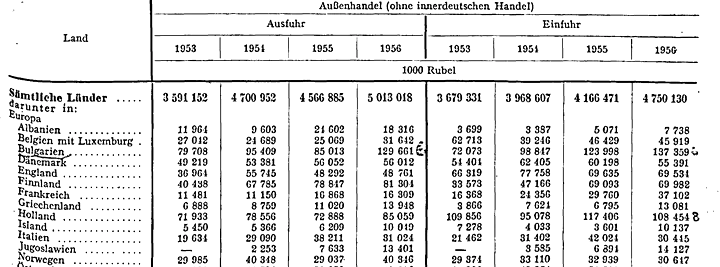Bilateral trade data for East bloc countries

This page contains historical trade data for East Germany and the USSR collected from primary sources. Files are available in comma-separated and Stata formats. For the convenience of those who wish to include these data in TRADHIST, we provide a single file that can be merged with this database, as well as separate files containing all bilateral trade flows for each country.
Suggested citation
Campos, Rodolfo G., Benedikt Heid, and Jacopo Timini (2024): The economic consequences of geopolitical fragmentation: Evidence from the Cold War, arXiv:2404.03508 [econ.GN].
- Bibtex format: .bib
Single file to merge with TRADHIST (version 4)
- Comma-separated values: east_data_for_merging.csv
- Stata format: east_data_for_merging.dta
These files contain only a subset of the data we collected. This subset is selected so that when merged with the TRADHIST database (Fouquin and Hugot, 2016), data will only be replaced in two cases:
- if an observation has East Germany or the USSR as the importing country and the value in TRADHIST is reported by the exporting country;
- if data for a particular country pair and year are missing from TRADHIST.
In order to merge it with TRADHIST, place the file east_data_for_merging.dta in the same directory as the file TRADHIST_v4.dta and run the following commands:
use TRADHIST_v4.dta, clear
merge 1:1 iso_o iso_d year using east_data_for_merging.dta
drop _merge
Country files
The complete set of observations collected from primary sources is available in the following separate files. A description of variables is given in the first sheet of the Excel file east_data.xslx.
- East Germany (1950-1974)
- East Germany (non-directional, 1950-1988)
- Comma-separated values: edeu_total.csv
- Stata format: edeu_total.dta
- Notes: flows reported are the sum of the value bilateral exports and imports, all flows use f.o.b. valuation
- Trade flows between East and West Germany (West German source, 1948-1989)
- Comma-separated values: innerdeutsch.csv
- Stata format: innerdeutsch.dta
- Notes: exports of West Germany use f.o.b. valuation, imports of West Germany use c.i.f. valuation
- USSR (1950-1988)
- All countries
- Excel format: east_data.xlsx
Sources
Bilateral trade flows for the GDR are collected from the annual editions of the Statistisches Jahrbuch der Deutschen Demokratischen Republik. Bilateral trade flows for the USSR are collected from the annual statistical yearbooks for foreign trade for the USSR (Внешняя торговля СССР (Статистический обзор)). Trade flows between East and West Germany (West German source) are from the West German Statistical Office (Statistisches Bundesamt).
Methodology
We replicate the exact steps that the IMF would have taken to include these bilateral trade flows in its DOTS database, had it had access to the data in the statistical yearbooks. We use the exchange rates reported in the IMF’s International Financial Statistics (IFS), or the official exchange rate if it is not available, to convert trade values from local currency to U.S. dollars. We also make the adjustment for c.i.f./f.o.b. discrepancies recommended by the DOTS methodology (IMF, 2003). In line with general DOTS practice, we update estimates to the latest published value when there are revisions from one year to the next. We have verified that the export values obtained in this way are virtually identical to those reported in DOTS for the years for which they are available for East Germany and the Soviet Union. For a detailed discussion of the methodology, see Campos et al. (2024).
References
Campos, Rodolfo G., Benedikt Heid, and Jacopo Timini (2024): The economic consequences of geopolitical fragmentation: Evidence from the Cold War, arXiv:2404.03508 [econ.GN].
Fouquin Michel and Jules Hugot (2016): Two Centuries of Bilateral Trade and Gravity Data: 1827-2014, CEPII Working Paper 2016-14.
International Monetary Fund (1993): A Guide to Direction of Trade Statistics, USA: International Monetary Fund.
Acknowledgments
We thank Rodrigo Peña for his help in transcribing the data and Marina Diakonova for her help in locating the digitized copies of the statistical reports on foreign trade of the USSR.